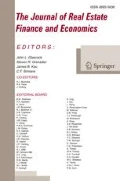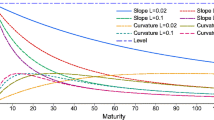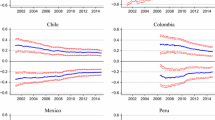Abstract
This paper examines twenty-seven international real estate securities indices from twenty countries and regions for calendar effects. Two methodologies are employed. The first is the standard approach which detects statistically significant anomalies via linear regression of returns. The second, new to the real estate securities literature, tests for economically significant effects through two tests specifically designed to compare multiple forecasts to a benchmark, White’s (Econometrica, 1097–1126, 2000) Reality Check and Hansen’s (J Bus Econ Stat 23(4):365–380, 2005) Superior Predictive Ability test. The standard approach tells us that while some effects have disappeared over time, statistically significant calendar anomalies persist. However, the tests of White and Hansen strongly suggest that they are not economically significant and thus should not be the basis of an investor’s trading strategy nor be considered as a challenge to market efficiency, as has been claimed previously.
Similar content being viewed by others
Notes
Serrano and Hoesli (2009) note that “The GPR General Quoted Index is a sub-index of the GPR General Index in which the bank funds are excluded.” According to the GPR website, their General Quoted Index is updated monthly.
The correlations of the 69 GPR Indices which met our requirements for minimum number of observations are available from the authors upon request.
References
Almudhaf, F., & Hansz, J. (2011). Systematic equity return patterns in listed European property companies. International Real Estate Review, 14(1), 61–84.
Brounen, D., & Ben-Hamo, Y. (2009). Calendar anomalies: the case of international property shares. The Journal of Real Estate Finance and Economics, 38(2), 115–136.
Chan, S., Leung, W., Wang, K. (2005). Changes in REIT structure and stock performance: evidence from the monday stock anomaly. Real Estate Economics, 33(1), 89–120.
Colwell, P., & Park, H. (1990). Seasonality and size effects: the case of real-estate-related investment. The Journal of Real Estate Finance and Economics, 3(3), 251–259.
Connors, D., Jackman, M., Lamb, R., Rosenberg, S. (2002). Calendar anomalies in the stock returns of real estate investment trusts. Briefings in Real Estate Finance, 2(1), 61–71.
Fama, E. (1970). Efficient capital markets: a review of theory and empirical work. Journal of Finance, 25(2), 383–417.
Fama, E. (1991). Efficient capital markets: II. Journal of Finance, 46(5), 1575–1617.
Friday, H., & Higgins, E. (2000). The day of the week effect in real estate investment trusts. Journal of Real Estate Portfolio Management, 6(3), 273–282.
Friday, H., & Peterson, D. (1997). January return seasonality in real estate investment trusts: information vs. tax-loss selling effects. Journal of Financial Research, 20(1), 33–51.
Hansen, P. (2005). A test for superior predictive ability. Journal of Business & Economic Statistics, 23(4), 365–380.
Hardin III, W., Liano, K., Huang, G. (2005). Real estate investment trusts and calendar anomalies: revisited. International Real Estate Review, 8(1), 83–94.
Jensen, M. (1978). Some anomalous evidence regarding market efficiency. Journal of Financial Economics, 6(2/3), 95–101.
Lee, M., & Lee, M. (2003). Institutional involvement and the REIT January effect over time. Journal of Property Investment & Finance, 21(6), 435–449.
Lenkkeri, V., Marquering, W., Strunkmann-Meister, B. (2006). The Friday effect in European securitized real estate index returns. The Journal of Real Estate Finance and Economics, 33(1), 31–50.
Redman, A., Manakyan, H., Liano, K. (1997). Real estate investment trusts and calendar anomalies. Journal of Real Estate Research, 14(1), 19–28.
Serrano, C., & Hoesli, M. (2009). Global securitized real estate benchmarks and performance. Journal of Real Estate Portfolio Management, 15(1), 1–19.
Sullivan, R., Timmermann, A., White, H. (1999). Data-snooping, technical trading rule performance, and the bootstrap. The Journal of Finance, 54(5), 1647–1691.
Sullivan, R., Timmermann, A., White, H. (2001). Dangers of data mining: the case of calendar effects in stock returns. Journal of Econometrics, 105(1), 249–286.
Tsay, R. (2005). Analysis of financial time series (Vol. 543). New York: Wiley-Interscience.
White, H. (1980). A heteroskedasticity-consistent covariance matrix estimator and a direct test for heteroskedasticity. Econometrica, 48(4), 817–838.
White, H. (2000). A reality check for data snooping. Econometrica, 68(5), 1097–1126.
Wiley, J., & Zumpano, L. (2009). Institutional investment and the turn-of-the-month effect: evidence from reits. The Journal of Real Estate Finance and Economics, 39(2), 180–201.
Acknowledgements
This study receives financial support from The Hong Kong Polytechnic Universitys Internal Funding (Project #: G-YH86, G-YH96, and 4-ZZC8). The second author, John Wright would like to thank the The Hong Kong Polytechnic University for their support, as much of his work for this paper was completed there. The third author, Phillip Yam, acknowledges financial support from The Hong Kong RGC GRF 502909, The Chinese University of Hong Kong Direct Grant 2010/2011 Project ID: 2060422, The Chinese University of Hong Kong Direct Grant 2011/2012 Project ID: 2060444. Phillip Yam also expresses his sincere gratitude to the hospitality of Mathematisches Forschungsinstitut Oberwolfach (MFO) in the German Black Forest during the preparation of the present work.
Author information
Authors and Affiliations
Corresponding author
Rights and permissions
About this article
Cite this article
Hui, E.C.M., Wright, J.A. & Yam, S.C.P. Calendar Effects and Real Estate Securities. J Real Estate Finan Econ 49, 91–115 (2014). https://doi.org/10.1007/s11146-012-9398-4
Published:
Issue Date:
DOI: https://doi.org/10.1007/s11146-012-9398-4




